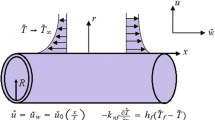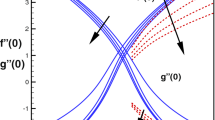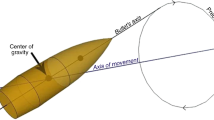Abstract
The utilization of nanometre-sized solid particles in working fluids has been seriously recommended due to their enhanced thermal characteristics. This suspension of solid particles in base fluids can significantly enhance the physical properties, such as, viscosity and thermal conductivity. They are widely used in several engineering processes, like, heat exchangers, cooling of electronic equipment, etc. In this exploration, we attempt to deliver a numerical study to simulate the nanofluids flow past a circular cylinder with convective heat transfer in the framework of Buongiorno’s model. A non-Newtonian Williamson rheological model is used to describe the behavior of nanofluid with variable properties (i.e., temperature dependent thermal conductivity). The leading flow equations for nanofluid transport are mathematical modelled with the assistance of Boussinesq approximation. Numerical simulation for the system of leading non-linear differential equations has been performed by employing versatile, extensively validated, Runge–Kutta Fehlberg scheme with Cash–Karp coefficients. Impacts of active physical parameters on fluid velocity, temperature and nanoparticle concentration is studied and displayed graphically. It is worth to mention that the temperature of non-Newtonian nanofluids is significantly enhanced by higher variable thermal conductivity parameter. One major outcome of this study is that the nanoparticle concentration is raised considerably by an increasing values of thermophoresis parameter.










Similar content being viewed by others
Abbreviations
- a, β :
-
Positive constants
- t :
-
Time
- ρ :
-
Density of the fluid
- B 0 :
-
Strength of magnetic field
- μ ∞ :
-
Viscosity at infinite shear rate
- μ 0 :
-
Viscosity at zero shear rate
- β * :
-
Viscosities ratio
- x, r :
-
Cylindrical polar coordinates
- u, v :
-
Velocity components
- U w :
-
Stretching cylinder velocity
- Γ :
-
Relaxation time
- ν :
-
Kinematic viscosity
- σ :
-
Electrical conductivity
- T f :
-
Temperature of hot fluid
- h f :
-
Heat transfer coefficient
- T :
-
Temperature of the fluid
- C :
-
Concentration of nanoparticles
- T ∞ :
-
Free stream temperature
- C ∞ :
-
Free stream nanoparticles concentration
- D B :
-
Brownian diffusion coefficient
- D T :
-
Thermophoretic diffusion coefficient
- c p :
-
Specific thermal capacity
- k(T):
-
Variable thermal conductivity
- τ :
-
Ratio of effective heat capacities
- ψ :
-
Stream function
- f :
-
Dimensionless velocity
- θ :
-
Dimensionless temperature
- φ :
-
Dimensionless concentration
- η :
-
Dimensionless variable
- γ :
-
Curvature parameter
- We :
-
Weissenberg number
- A :
-
Unsteadiness parameter
- Pr:
-
Prandtl number
- Sc :
-
Schmidt number
- Nt :
-
Thermophoretic parameter
- Nb :
-
Brownian motion parameter
- Re :
-
Local Reynolds number
- (ρc)f :
-
Heat capacity of the fluid
- (ρc)p :
-
Heat capacity of nanoparticles
- τ w :
-
Surface shear stress
- C f :
-
Skin friction coefficient
- Nu :
-
Nusselt number
- Sh :
-
Sherwood number
- q w :
-
Surface heat flux
- q m :
-
Surface mass flux
- γ 1 :
-
Thermal Biot number
- γ 2 :
-
Concentration Biot number
References
Acharya N, Das K, Kundu PK (2017) Framing the features of MHD boundary layer flow past an unsteady stretching cylinder in presence of non-uniform heat source. J Mol Liq 225:418–425
Akl MY (2014) Unsteady boundary layer flow along a stretching cylinder an analytical solution. J Math Stat 10:117–124
Buongiorno J (2006) Convective transport in nanofluids. J Heat Transf 128:240–250
Choi SUS (1995) Enhancing thermal conductivity of fluids with nanoparticles. ASME Publ Fed 231:99–106
Dogonchi AS, Ganji DD (2018) Effects of Cattaneo-Christov heat flux on buoyancy MHD nanofluid flow and heat transfer over a stretching sheet in the presence of Joule heating and thermal radiation impacts. Indian J Phys 92:757–766
Fang T, Zhang J, Yao S (2009) Slip MHD viscous flow over a stretching sheet:exact solution. Commun Nonlinear Sci Numer Simul 14:3731–3737
Fang T, Zhang J, Zhong Y (2012) Note on unsteady viscous flow on the outside of an expanding or contracting cylinder. Commun Nonlinear Sci Numer Simul 17:3124–3128
Fathizadeh M, Madani M, Khan Y, Faraz N, Yildirim A, Tutkun S (2013) An effective modification of the homotopy perturbation method for MHD viscous flow over a stretching sheet. J King Saud Univ Sci 25:107–113
Haq RU, Soomro FA, Hammouch Z, Rehman SU (2018a) Heat exchange within the partially heated C-shape cavity filled with the water based SWCNTs. Int J Heat Mass Transf 127:506–514
Haq RU, Soomro FA, Mekkaoui T, Al-Mdallal Q (2018b) MHD natural convection flow enclosure in a corrugated cavity filled with a porous medium. Int J Heat Mass Transf 121:1168–1178
Hashim, Khan M, Alshomrani AS (2017) Characteristics of melting heat transfer during flow of Carreau fluid induced by a stretching cylinder. Eur Phys J E 40:8. https://doi.org/10.1140/epje/i2017-11495-6
Hayat T, Asad S, Alsaedi A (2014) Flow of variable thermal conductivity fluid due to inclined stretching cylinder with viscous dissipation and thermal radiation. Appl Math Mech 35:717–728
Hayat T, Saeed Y, Asad S, Alsaedi A (2016) Convective heat and mass transfer in flow by an inclined stretching cylinder. J Mol Liq 220:573–580
Imtiaz M, Hayat T, Alsaedi A (2016) Mixed convection flow of Casson nanofluid over a stretching cylinder with convective boundary conditions. Advanced Powd Tech 27:2245–2256
Ishak A, Nazar R, Pop I (2008) Magnetohydrodynamic (MHD) flow and heat transfer due to a stretching cylinder. Energy Convers Manag 49:3265–3269
Khan M, Malik R (2016) Forced convective heat transfer to Sisko nanofluid past a stretching cylinder in the presence of variable thermal conductivity. J Mol Liq 218:1–7
Kuznetsov AV, Nield DA (2013) The Cheng-Minkowycz problem for natural convective boundary layer flow in a porous medium saturated by a nanofluid: a revised model. Int J Heat Mass Transf 65:682–685
Mukhopadhyay S (2013) MHD boundary layer slip flow along a stretching cylinder. Ain Shams Eng J 4:317–324
Nield DA, Kuznetsov AV (2009) Thermal instability in a porous medium layer saturated by a nanofluid. Int J Heat Mass Transf 5:5796–5801
Reddy PBA, Das R (2016) Estimation of MHD boundary layer slip flow over a permeable stretching cylinder in the presence of chemical reaction through numerical and artificial neural network modeling. Eng Sci Tech Int J 19:1108–1116
Sheikholeslami M (2017) Influence of Lorentz forces on nanofluid flow in a porous cylinder considering Darcy model. J Mol Liq 225:903–912
Sheikholeslami M, Ellahi R (2015) Three dimensional mesoscopic simulation of magnetic field effect on natural convection of nanofluid. Int J Heat Mass Transf 89:799–808
Si X, Li L, Zheng L, Zhang X, Liu B (2014) The exterior unsteady viscous flow and heat transfer due to a porous expanding stretching cylinder. Comp Fluids 105:280–284
Usman M, Haq RU, Hamid M, Wang W (2018a) Least square study of heat transfer of water based Cu and Ag nanoparticles along a converging/diverging channel. J Mol Liq 249:856–867
Usman M, Soomro FA, Haq RU, Wang W, Defterli O (2018b) Thermal and velocity slip effects on Casson nanofluid flow over an inclined permeable stretching cylinder via collocation method. Int J Heat Mass Transf 122:1255–1263
Usman M, Hamid M, Haq RU, Wang W (2018c) Heat and fluid flow of water and ethylene-glycol based Cu-nanoparticles between two parallel squeezing porous disks: LSGM approach. Int J Heat Mass Transf 123:888–895
Vajravelu K, Prasad KV, Santhi SR (2012) Axisymmetric magneto-hydrodynamic (MHD) flow and heat transfer at a non-isothermal stretching cylinder. Appl Math Comput 219:3993–4005
Wang CY (1988) Fluid flow due to a stretching cylinder. Phys Fluids 31:466–468
Zaimi K, Ishaq A, Pop I (2014) Unsteady flow due to a contracting cylinder in a nanofluid using Buongiorno’s model. Int J Heat Mass Transf 68:509–513
Author information
Authors and Affiliations
Corresponding author
Additional information
Publisher's Note
Springer Nature remains neutral with regard to jurisdictional claims in published maps and institutional affiliations.
Rights and permissions
About this article
Cite this article
Hashim, Hamid, A. & Khan, M. Transient flow and heat transfer mechanism for Williamson-nanomaterials caused by a stretching cylinder with variable thermal conductivity. Microsyst Technol 25, 3287–3297 (2019). https://doi.org/10.1007/s00542-019-04364-9
Received:
Accepted:
Published:
Issue Date:
DOI: https://doi.org/10.1007/s00542-019-04364-9




